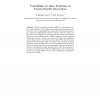Free Online Productivity Tools
i2Speak
i2Symbol
i2OCR
iTex2Img
iWeb2Print
iWeb2Shot
i2Type
iPdf2Split
iPdf2Merge
i2Bopomofo
i2Arabic
i2Style
i2Image
i2PDF
iLatex2Rtf
Sci2ools
RECOMB
2005
Springer
2005
Springer
Probabilistic in Silico Prediction of Protein-Peptide Interactions
Abstract. Peptide recognition modules (PRMs) are specialised compact protein domains that mediate many important protein-protein interactions. They are responsible for the assembly of critical macromolecular complexes and biochemical pathways (Pawson and Scott, 1997), and they have been implicated in carcinogenesis and various other human diseases (Sudol and Hunter, 2000). PRMs recognise and bind to peptide ligands that contain a speci
c structural motif. This paper introduces a novel discriminative model which models these PRMs and allows prediction of their behaviour, which we compare with a recently proposed generative model. We
nd that on a yeast two-hybrid dataset, the generative model performs better when background sequences are included, while our discriminative model performs better when the evaluation is focused on discirminating between the SH3 domains. Our model is also evaluated on a phage display dataset, where consistantly out-performed the generative model.
Computational Biology | Discriminative Model | Generative Model | Generative Model Performs | RECOMB 2005 |
| Added | 28 Jun 2010 |
| Updated | 28 Jun 2010 |
| Type | Conference |
| Year | 2005 |
| Where | RECOMB |
| Authors | Wolfgang P. Lehrach, Dirk Husmeier, Christopher K. I. Williams |
Comments (0)

